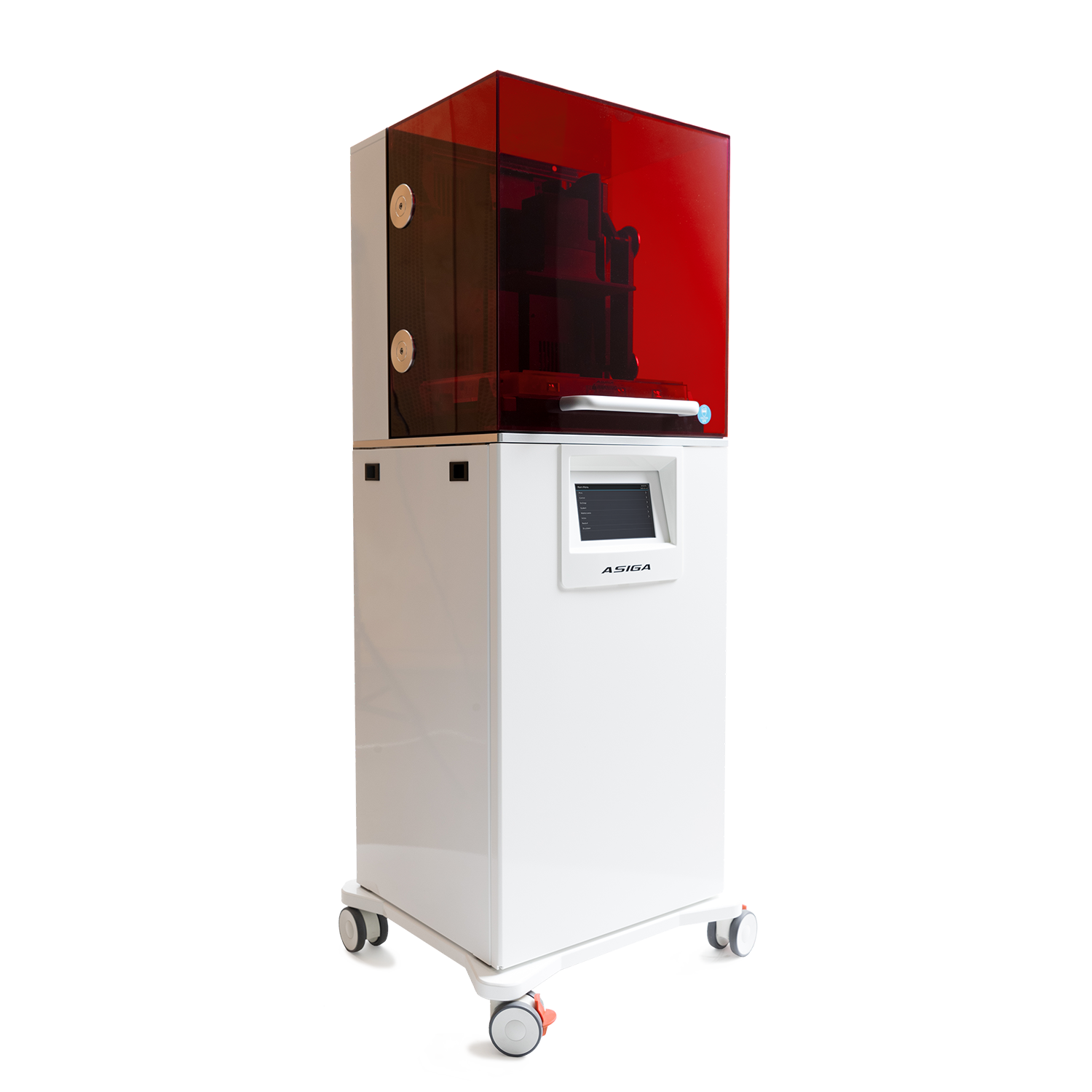So you are ready to start 3D printing and you can’t decide if you should go with the Whip Mix VeriBuild or the Asiga Max. These two popular printers have several differences including price point, yet they both have a place in our industry. Instead of choosing by Eenie, Meenie, Miney, Mo, let me break them both down, to show their strengths and weaknesses, in order to help you determine which one will best suit your needs.
DLP vs LCD
The Asiga Max uses DLP technology, whereas the VeriBuild uses LCD technology. At the end of the day, DLP technology is more expensive to manufacture than LCD technology. The cost to get started with the Asiga Max is $10,990 vs the VeriBuild at $3,500.
The advantage that the Asiga Max has over the Whip Mix VeriBuild as a DLP printer is speed. The Max will print more than three times faster than the VeriBuild. As an example, using a 100 micron layer thickness, you can print approximately 50mm in one hour on the Max vs. 15mm in one hour on the VeriBuild.
X,Y Accuracy
The Asiga Max's advantage is in its speed, but the Whip Mix VeriBuild has some of its own advantages -- aside from being significantly less expensive. Because the VeriBuild is an LCD printer, the x,y accuracy is at 47 micron vs. 62 micron on the Asiga Max. In order to get a more accurate print on the x,y axes with a DLP printer, the projector has to be really close to the glass, which in turn means there is a smaller print envelope. There has to be a balance with a reasonable print envelope and accuracy. This means that with the Asiga Max you sacrifice a little of the x,y accuracy to maintain a similar print envelope size as the VeriBuild. Consider, though, that 62 microns is still very accurate.
385nm vs 405nm Wavelength
Another advantage that the Asiga Max offers is its 385 nanometer light processor vs. the VeriBuild’s 405 nanometer light processor. This means that there are virtually an unlimited number of resins you can print on Asiga Max. It is also an open materials printer. You can print a resin formulated for a 405 wavelength on a 385 printer, but you cannot print a resin formulated for a 385 wavelength on a 405 printer.
Maintenance
The Whip Mix Veribuild has a an advantage over the Asiga Max in regards to its maintenance. If the projector goes out on the Asiga Max, you have to send your printer back to Whip Mix for one of our certified technicians to replace the projector. If you need a new projector, it is $6,000 and carries a 1 year warranty. You do, however, have a choice to go with a refurbished projector, which carries a 6 month warranty when you trade in your old projector. This will cost you a little under $2,000.
When an LCD panel goes out on the VeriBuild, you can repair it yourself. The printer comes with 3 LCD panels. A panel will typically last about 3 months. Obviously that number is subjective depending on use. It takes about 5 minutes to replace it. You can buy a 3 pack of LCD panels for $300.00. Here is a link to a video showing you how to replace the LCD panel yourself.
Consumables
Both printers have consumables tied to them. The Asiga Max uses a tray system and the Whip Mix VeriBuild uses a vat. The LCD panel is also considered a consumable with the VeriBuild as well.
With the Asiga Max, you can get trays rated for use for 1, 2, 5 or 10 liters of resin. These trays are all physically the same size. What is different is the grade of teflon on the bottom of the tray. You are not pouring an entire bottle of resin into the tray at once, but instead topping it off after each print job. With DLP technology, the UV light flashes in between each layer that is printed. Over time, the teflon becomes cloudy, which can cause inaccurate prints. Overusing the tray can cause it to become brittle and crack, which can allow resin to leak all over your printer. If this happens, it is not the end of the world. You have a mess to clean up and you lost some resin.
Each tray has an RFID tag on the outside of the tray, which is read by the printer. At the end of each print job, the printer will tell you how much useful life is left in the tray. You will want to dedicate a tray for each resin to minimize the risk of damaging the tray and wasting resin. Save the box the tray came in and store it in the box when you are not using it. The price of a 1L tray is $85, 2L is $130, 5L is $215 and the 10L tray is $295. Typically for models, I recommend going with the 5L tray because this will cut your cost down to $43 per liter on your tray usage. When printing smaller objects, like temporaries or castables, you will definitely want to go with a 1L tray. The Asiga Max will come with a 1L tray to get you started.
As I stated before, the VeriBuild printer uses a vat system instead of a disposable tray. You will get 2 of the metal vats with your printer and 2 resin vat film sheets. Each sheet can be cut in half, giving you 4 sheets for the resin vats. You will need to change the sheet out if you get dimples or a hole in them to avoid print failures. So it is imperative to maintain a clean work space and handle your vats with care to extend the life of each sheet. Typically, you can expect to be able to run about 10 liters of resin through the vat with each film sheet. This will be dependent on your care and handling of the resin vat. You can buy replacement vat film sheets in a pack of two for $150. This gives you a total of 4 sheets to work with once you cut them in half. It will take you about 20 minutes to replace a sheet. Here is a quick video showing you how to replace the vat film sheet.
Conclusion
The Asiga Max is clearly the winner when it comes to speed and having over 400 resins to choose from with a dental application. This printer will certainly grow with your business. It is accurate and an all-around a solid choice. If speed is not an issue and you are just looking at printing accurate models, dentures, temporaries and surgical guides, the Whip Mix VeriBuild is a great, economical choice.
There are more resins in development with the VeriBuild printer, but the Max has a diverse offering right out the gate. If you have the counter space, why not have 3 VeriBuild printers lined up for less than cost of an Asiga Max printing simultaneously with different resins? There is a lot to consider when making this decision. At the end of the day you can’t go wrong with either of them.



.jpg)








Leave a comment